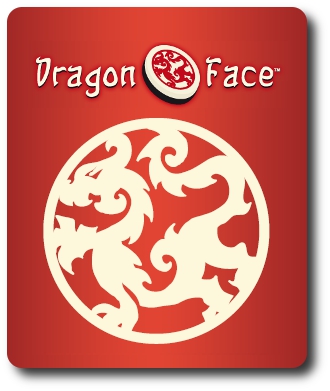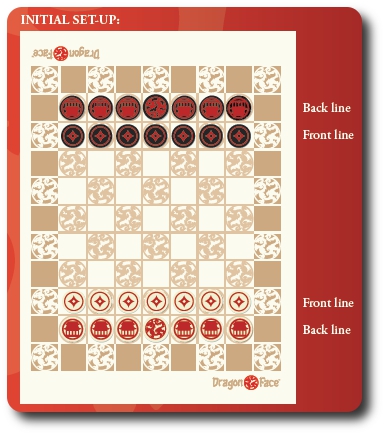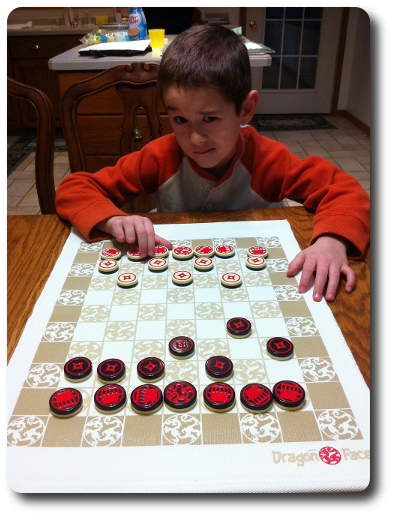
The Basics:
- For ages 7 and up (publisher suggests 8+)
- For 2 players
- About 40 minutes to complete
Geek Skills:
- Logical & Critical Decision Making
- Strategy & Tactics
- Risk vs. Reward
- Bluffing and Misdirection
- Area Control
Learning Curve:
- Child – Moderate
- Adult – Easy
Theme & Narrative:
- Two powerful opposing forces face-off to determine, once and for all, who shall rule
Endorsements:
- Gamer Geek approved!
- Parent Geek approved!
- Child Geek approved!
Overview
In our distant future, the universe has been separated not by power or property, but by a single idea. More powerful than all the weapons known to man, this idea has the ability to create empires and crush civilizations. Not because the idea itself has any power, but because those who follow this idea will stop at nothing to see it cross from one end of existence to the other. Only two empires remain in this destructive and timeless war of ideology. Now the universe goes quiet and the past, present, and future all hinge on this last battle.
Dragon Face from BlueOrange is comprised of 1 game mat and 28 playing pieces. The game mate is made of thick and very durable cloth. The playing pieces have two sides, a white face with red lettering and a black face with red lettering. The playing pieces are solid with just enough weight to keep them on the game mat. The game fits in a red tube with embossed lettering. The entire game is exceedingly well crafted and designed, immediately drawing the eye and interest.
The Eternal Battleground
The game mat has 99 alternating squares that go from light to dark giving the impression of a Chess or Checkers board. The game mat is further dividing into two sections. These are the “Territories” which are repented by the 63 central squares, and the “Sacrifice Zone” which is represented by the 36 outer squares that surround the Territories.

From top to bottom: the Emperor, the Ambassador, and the Governor
The Warriors of Ideology
Each player will be given the same number of game pieces, but the players will choose opposite colors to play with. Regardless of coloring, the pieces play the same.
The Emperor
The supreme ruler and guardian of the values of the empire. The Emperor can move in any direction on the board, but only one square at a time.
The Ambassadors
The mouth of the Emperor who ensure that from one corner to the next, the values of the empire are understood and followed. The Ambassadors can move in a straight line in any direction along uninterrupted squares.
The Governors
The hands that insure the will of the Emperor is carried out to the letter and the vast empire is well taken care. The Governors can only move forward, one square at a time. The only exception is when it moves for the first time, in which case it can move two squares in the same direction.
A Conflict of Ideals and the Ultimate Sacrifice
When playing, opposing player pieces are captured by being “jumped over” in the same way you would capture a piece playing Checkers. This is done with the game pieces moving as normal, but if there is an opposing piece blocking the move, it is “jumped”. Note that a jump must allow the piece to land in an unoccupied square in the direction the piece was being moved.
Once the piece is captured, it immediately switches sides and is now a piece that is controlled and belongs to the player who captured it. The newly captured piece is also temporarily immune to being captured again until the player’s next turn, meaning it cannot be immediately recaptured by the player who just lost it.
Surrounding the Territories is the Sacrifice Zone. Pieces can only enter this zone by jumping into it, resulting in a capture. If a Governor piece should ever sacrifice itself, the piece shall remain there for the duration of the game. If an Ambassador should ever be sacrificed, it also remains but only until the player has moved one of his Governor pieces to or across their opponent’s back line (see “Game Set Up” below). One the Governor piece has reached the back line or passed it, the player may then choose to retrieve the Ambassador or leave it where it currently is. If the player chooses to retrieve the Ambassador, the Governor that was sacrificed is placed underneath the Ambassador piece. On the player’s following turns they may move the Ambassador resting on top of the Governor out of the Sacrifice Zone using the piece’s normal movement rules. The Governor piece remains. The Emperor can never move into the Sacrifice Zone.
Game Set Up
To set up the game, unroll the game mat and place it in the middle of the playing area. The players will sit opposite of each other. Next give each player 1 Emperor piece, 6 Ambassador pieces, and 7 Governor pieces for a total of 14 pieces each. Each player should choose a color, making certain it is opposite of their opponent’s color selection. The selected color will represent the player for the duration of the game.
Each player has a starting back line and a front line. The back line is the closest row to the player that is bordering on the Sacrifice Zone. Here each player will place their Emperor and Ambassadors, with the Emperor being in the middle with 3 Ambassadors to the left and right of the piece. The front line is entirely populated by Governors. Once the board is set, it will look like the following image.

Playing and Winning the Game
Once the game has been set, the player who owns the white pieces goes first. Each player takes a single turn which allows them to move one of their game pieces in any legal direction. Remember that the Governors can move 2 spaces on their first turn. Taking turns and moving their pieces, the board will be dominated by one player and then the other, as the pieces shift from light to dark and back again. The game continues, with pieces being shifted and sacrificed until one of the Emperor pieces is jumped. When two Emperors on the game mat share the same ideology (i.e. the same color), the war ends and the player who captured their opponent’s Emperor wins the game.
To learn more about Dragon Face, see the game’s official web site. Be sure to checkout the corny but very humorous game teaser video. Well worth your time.
Prediction
My little geeks can play Checkers and I am just now teaching them Chess. Jumping, if you’ll excuse the pun, from Checkers to Chess is not an easy transition. While the concept of capturing pieces it the same, the movement restrictions on the pieces make for a very different game experience. If we conceptualize this “logic and skill jump”, Dragon Face would be the stepping stone between the two games. In fact, Dragon Face plays like the forbidden love child of Chess and Checkers, and what a beautiful baby it is. Simple and elegant like Checkers but complex and deeply strategic like Chess. In a way, the watering down of Chess and beefing up of Checkers to create Dragon Face has resulted in a game that is simplistically complicated, if you can wrap your mind around that concept.
For my 4-year-old, I doubt this game will be a winner. He is doing very well with Checkers but has not yet demonstrated he understands the deeper side of the game. His moves are all reactionary in nature and his single-minded approach to each play is to jump as often as he can. His highly aggressive style is borderline beserkerish and leaves him open to many opportunities for defeat.
His older brother, age 7, plays with much more finesse and direction. He thinks his moves out and visualizes what the pieces are doing, knowing what the result will be before he moves them. His early lessons with Chess have shown him to be a quick learner but still a novice when it comes to the deeper level of strategy and tactics involved in the game.
For these reasons, I think Dragon Face will be very well received by my 7-year-old and almost totally ignored by my 4-year-old.
Nevertheless, I showed the game to all my little geeks, including my 2-year-old. They might not be at the same level, skill wise, but their passion and excitement for games is equal and unmatched. As expected, all three loved the game mat and the game pieces. They just look and feel “right”, which is hard to explain and only truly appreciated when you are sitting down with the game. My 2-year-old wanted to play with the game bits, which I was happy to let him do. The game’s component’s are very durable, and short of my 2-year-old using a flamethrower on them, the pieces were going to be just fine. I took this opportunity, while my 2-year-old was occupied, to explain the game to my little geeks, showing them how the different pieces moved and what the end goal of the game was.
My 4-year-old lost interest about halfway through my game explanation and opted to go get his copy of Minotaurus instead. My 7-year-old remained interested and asked some very insightful questions. It was clear his mind was wrapping around the game’s fundamental concepts and he would be able to play. And so, while I set up the game mat, listening to my 4 and 2-year-old play Minotaurus, I asked my little geek his thoughts of the game so far.
“I really like how the game looks and sounds like Checkers but uses pieces like Chess.” ~ Liam (age 7)
Exactly. Let’s see if this blend of the two most well-known abstract games is a winner or not enough of either to be of any use.
Final Word
I am so very pleased I introduced Dragon Face to my son. It felt like a breath of fresh air and very rewarding. I have played Checkers and Chess for so long that I had all but gone completely numb from the experience. These games are very old hats to me, familiar, and not at all exciting. I keep them in the house because they are excellent games to learn how to play and teach important geek skills. But I view them nowadays as “tools” and not a game I would seek out to play. As they are new to my little geeks, there is a level of excitement at the table I can feed off of, but it is short-lived.
Interestingly enough, Dragon Face “feels” different to me even though it is not introducing much in the way that is new or ground breaking. It’s a new way to play Chess and Checkers, and not much else. But the game play puts a new spin on old classics and I have found much enjoyment using what I have learned and using it in a new way. New enough to grab my interest and be entertaining, but hardly unique. Not a bad thing and I’d argue it is one of the game’s greatest strengths.
My 7-year-old greatly enjoys Dragon Face for two reasons. First, he tells me it feels like a more interesting game of Checkers. Second, he can beat me at the game. I can outmaneuver him on the game mat but for only so long. The piece movement restrictions limit the player’s ability to take over the entire game with only a few pieces. Victory is won through subtle play and, to some extent, misdirection. You’ll need to bait your opponent so they move their pieces providing you an opportunity to capture and control.
The Sacrifice Zone is an interesting touch in the game and will make any gamer stop and think if capturing a game piece is worth the cost. The playing area is small and options can be limited. Sometimes sacrificing a piece to advance is an easy choice to make, but more times than not, it’s a difficult one. This was a real surprise and I was delighted that I had to stop and really think about my moves.
Lastly, because this is an abstract game, it focuses more on game play than using theme and narrative to connect to the players. Regardless of lack of theme, my brain always tries to wrap one around the game. This has greatly helped me play abstract games as it provides context. My 7-year-old feels the same way. Where I saw two opposing intergalactic houses battling for political and cultural control, my 7-year-old saw Ninja zombies. According to him, if you “jump” over the other piece, you cure them and if they get flipped to the other side, they have been zombified! I rather like his point-of-view.
While playing with my little geek was rewarding and fun, playing with adults is an exercise in focus and mental stamina. Like Chess and Checkers, there is a built-in complexity that only surfaces when you play against an opponent that utilizes them. Dragon Face is no exception, and every adult I have played with gave me a real run for my money or simply handed me my hat. This made the game exceedingly frustrating when I was losing but always a good time. I enjoy a good challenge and Dragon Face certainly provides it.

My little geek and I face-off for a game but I can already tell he has the advantage. What a look of confidence!
Gamer Geeks, Dragon Face is a challenging abstract game of area control that sits snuggly in the middle of Checkers and Chess. This makes it an excellent 2-player medium weight game that plays in less than an hour and feels very rewarding once you have completed it. Dragon Face also feels more “gamer focused” than the classics in which it is derived. It some ways, Dragon Face is very much the best of both Checkers and Chess, resulting in a familiar feeling game that can be exceedingly difficult to beat but not out of range to master.
Parent Geeks, Dragon Face is an excellent intermediate game to introduce to your little geeks who have learned how to play Checkers and are ready to start learning much more complicated abstract games. The additional level of difficulty for your little geeks, and anyone who is familiar with Chess, will be an easy one to learn and you’ll be playing in no time. The new movement rules and area restrictions are few but enough to make the game feel like something new and challenging. This is also a wonderful game for the non-gamer’s in your family and for anyone who likes a good 2-player abstract strategy game.
Child Geeks, this is a game that will take your Checker skills and your Chess skills and mash them together to play a game that uses both. You’ll need to carefully plan out your moves, think ahead, and always reevaluate the game mat. The game is won through small steps and knowing that a firm strategy will lead to victory. That being said, you might feel very frustrated at first as you play the game, but you’ll soon forget all about your frustration as you start to win game pieces and take over the game mat!
Dragon Face has replaced my family’s copy of Checkers and gets more attention than Chess at the moment. This is due, in some part, because it is new but also because it is simply a great game. It is challenging without being overbearing, deep without being bottomless, and a real thinker without melting your brain. The easy accessibility of the game makes it simple to teach and to play with a wide range of gamer types and ages. The end result is a wonderful abstract game that is sure to leave both sides of the table feeling very satisfied. Do take a look at Dragon Face if the opportunity should present itself!
This game was given to Father Geek as a review copy. Father Geek was not paid, bribed, wined, dined, or threatened in vain hopes of influencing this review. Such is the statuesque and legendary integrity of Father Geek.
Discover more from Father Geek
Subscribe to get the latest posts sent to your email.






Pingback: Father Geek » Skyvale Game Review
Pingback: Crowns Game Review » Father Geek
Pingback: Castle Danger Game Review (10th Anniversary Edition) » Father Geek